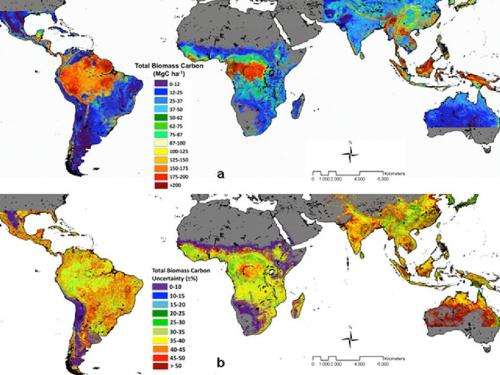New NASA map reveals patterns of tropical forest carbon storage

A NASA-led research team has used a variety of NASA satellite data to create the most precise map ever produced depicting the amount and location of carbon stored in Earth's tropical forests. The data are expected to provide a baseline for ongoing carbon monitoring and research and serve as a useful resource for managing the greenhouse gas carbon dioxide.
The new map, created from ground- and space-based data, shows for the first time the distribution of carbon stored in forests across more than 75 tropical countries. Most of that carbon is stored in the extensive forests of Latin America.
"This is a benchmark map that can be used as a basis for comparison in the future when the forest cover and its carbon stock change," said Sassan Saatchi of NASA's Jet Propulsion Laboratory in Pasadena, Calif., who led the research. "The map shows not only the amount of carbon stored in the forest, but also the accuracy of the estimate." The study was published May 30 in the Proceedings of the National Academy of Sciences.
Deforestation and forest degradation contribute 15 to 20 percent of global carbon emissions, and most of that contribution comes from tropical regions. Tropical forests store large amounts of carbon in the wood and roots of their trees. When the trees are cut and decompose or are burned, the carbon is released to the atmosphere.
Previous studies have estimated the carbon stored in forests on local and large scales within a single continent, but there existed no systematic way of looking at all tropical forests. To measure the size of the trees, scientists typically use a ground-based technique, which gives a good estimate of how much carbon they contain. But this technique is limited because the structure of the forest is extremely variable and the number of ground sites is very limited.
To arrive at a carbon map that spans three continents, the team used data from the Geoscience Laser Altimeter System lidar on NASA's ICESat satellite. The researchers looked at information on the height of treetops from more than 3 million measurements. With the help of corresponding ground data, they calculated the amount of above-ground biomass and thus the amount of carbon it contained.
The team then extrapolated these data over the varying landscape to produce a seamless map, using NASA imagery from the Moderate Resolution Imaging Spectroradiometer (MODIS) instrument on NASA's Terra spacecraft, the QuikScat scatterometer satellite and the Shuttle Radar Topography Mission.
The map reveals that in the early 2000s, forests in the 75 tropical countries studied contained 247 billion tons of carbon. For perspective, about 10 billion tons of carbon is released annually to the atmosphere from combined fossil fuel burning and land use changes.
The researchers found that forests in Latin America hold 49 percent of the carbon in the world's tropical forests. For example, Brazil's carbon stock alone, at 61 billion tons, almost equals all of the carbon stock in sub-Saharan Africa, at 62 billion tons.
"These patterns of carbon storage, which we really didn't know before, depend on climate, soil, topography and the history of human or natural disturbance of the forests," Saatchi said. "Areas often impacted by disturbance, human or natural, have lower carbon storage."
The carbon numbers, along with information about the uncertainty of the measurements, are important for countries planning to participate in the Reducing Emissions from Deforestation and Degradation (REDD+) program. REDD+ is an international effort to create a financial value for the carbon stored in forests. It offers incentives for countries to preserve their forestland in the interest of reducing carbon emissions and investing in low-carbon paths of development.
The map also provides a better indication of the health and longevity of forests and how they contribute to the global carbon cycle and overall functioning of the Earth system. The next step in Saatchi's research is to compare the carbon map with satellite observations of deforestation to identify source locations of carbon dioxide released to the atmosphere.
Provided by JPL/NASA















